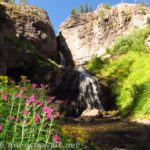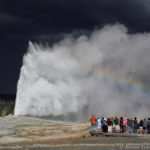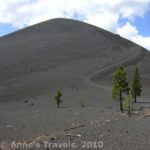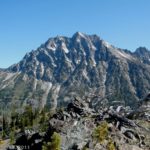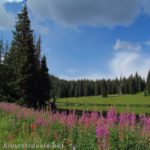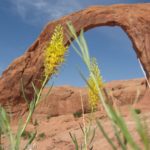
For the most part, when we go walking in the wilderness, we walk on dirt. The trail is typically sand or hard-packed dirt. The hills and valleys are covered with dirt, and even the mountains usually have dirt on them. Our yards are dirt, and the beaches are covered with sand (which I suppose is a kind of dirt). For the most part, if we look below the vegetation, we see dirt of one variety or another.

But if we were to dig down through the dirt, we would sooner or later arrive at rock. Near where I live, the rock beneath the dirt is red. Other places, the rock is brown or gray or white or even purple. But the good thing about the rock is that it is much less movable than dirt. You can shovel up dirt, even if it’s hard-packed (don’t ask how I know that). But you can’t just shovel up rock. You need something stronger to break it up- to make it closer to dirt – before you can move it.

Because rock is so unmoving, it makes a firm foundation. Bridge builders have for centuries dug down to bedrock to put down the footers to ensure that their bridges can stand against the strongest tides and floods. Skyscrapers’ designers determine how far down to rock they must go (and into the rock they must go) to make a sturdy building that won’t collapse.

We are all likely aware of the metaphor of God being our rock. The parable of the house built on the rock and on the sand is a good illustration of this (Matthew 7:24-27). If we build our house on the dirt – all of the things that are built on top of Christ (doctrines, rules, traditions, methodologies, etc.) – our faith is built on nothing but the dirt. We must somehow dig down through it all and establish our foundation on the rock of Who He is if we want our foundation to stand secure.

My dad worked in a Christian college for a number of years. It was tragic to him to watch as the freshman class came in every year, so sure of their pet doctrines and traditions. They knew the stories; they knew what they’d been told; they were the strongest Christians in their youth group. But they had never dug deeper than the dirt on top of the rock. And so, when faced by stormy winds, they either dug deeper in an emergency to the Rock or else were, metaphorically, washed away.

That’s not to say that all “dirt” is wrong or bad. God gives us guidelines, metaphors, and even traditions that He uses to strengthen and help our faith. In the natural world, beautiful plants don’t grow on rock. They grow in dirt. Does that mean that plants are bad because they don’t grow on the rock? Of course not! In the same way, all of the “dirt” on top of the Rock – Jesus – is not necessarily bad. But like trees that fall over in the wind, so we must not put our faith in what grows in the dirt.
Have you seen a rock formation, say an arch or a canyon or a rock spire? So we’re told, these rock formations were once under dirt. Over time, or with floods and other natural means, these formations were exposed so we can see them as they are – rock. In the same way, at times, God will blow away the “dirt” that surrounds the Rock that He is. When we see the rock exposed, we find the Rock that is our Firm Foundation – the One we can put our trust in and not be ashamed.


